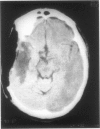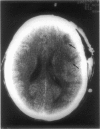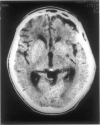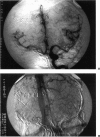Abstract
Balloon test occlusion (BTO) of the internal carotid artery (ICA) is used in conjunction with single-photon emission computed tomography (SPECT) imaging to assess the cerebrovascular collateral reserve prior to surgical manipulation of the artery. The present report reviews 56 consecutive patients with tumors or vascular lesions at the base of the skull who underwent BTO and subsequent treatment on that basis within a 3-year period. Four patients underwent carotid sacrifice, since they tolerated the BTO and had normal SPECT imaging. Postoperatively, one patient had patchy infarcts in the frontal lobe, another a middle cerebral artery territory infarction, a third had a lacunar infarct, and the fourth had an impending stroke and was treated with an emergent revascularization procedure. There were 15 patients who underwent saphenous vein bypass grafting, of these there were three graft occlusions, one of which resulted in an infarction. There were two other infarctions due to technical difficulties, one being related to the revascularization procedure. Based on these results, we suggest that passing BTO with a normal SPECT study does not necessarily indicate that the patient is immune to stroke following carotid sacrifice. Revascularization should be considered, when ICA sacrifice is deemed necessary to treat the pathologic condition adequately, to minimize the likelihood of a stroke.
Full text
PDF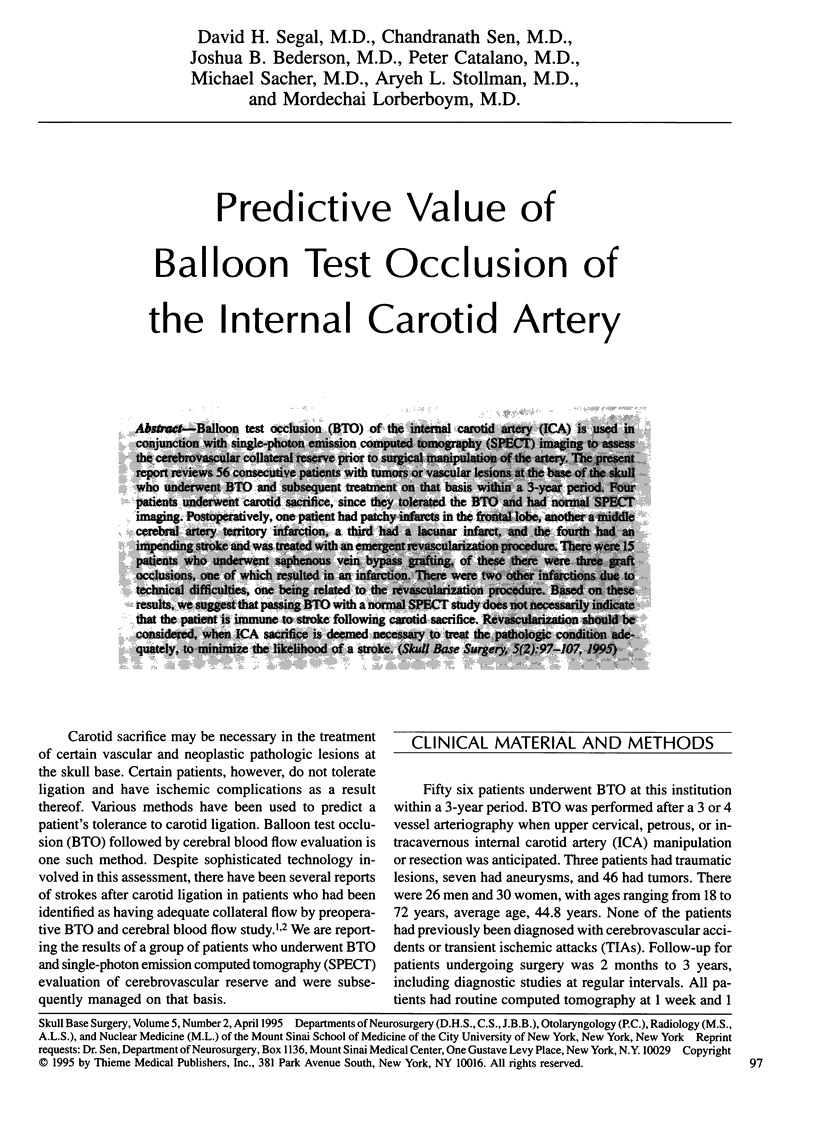
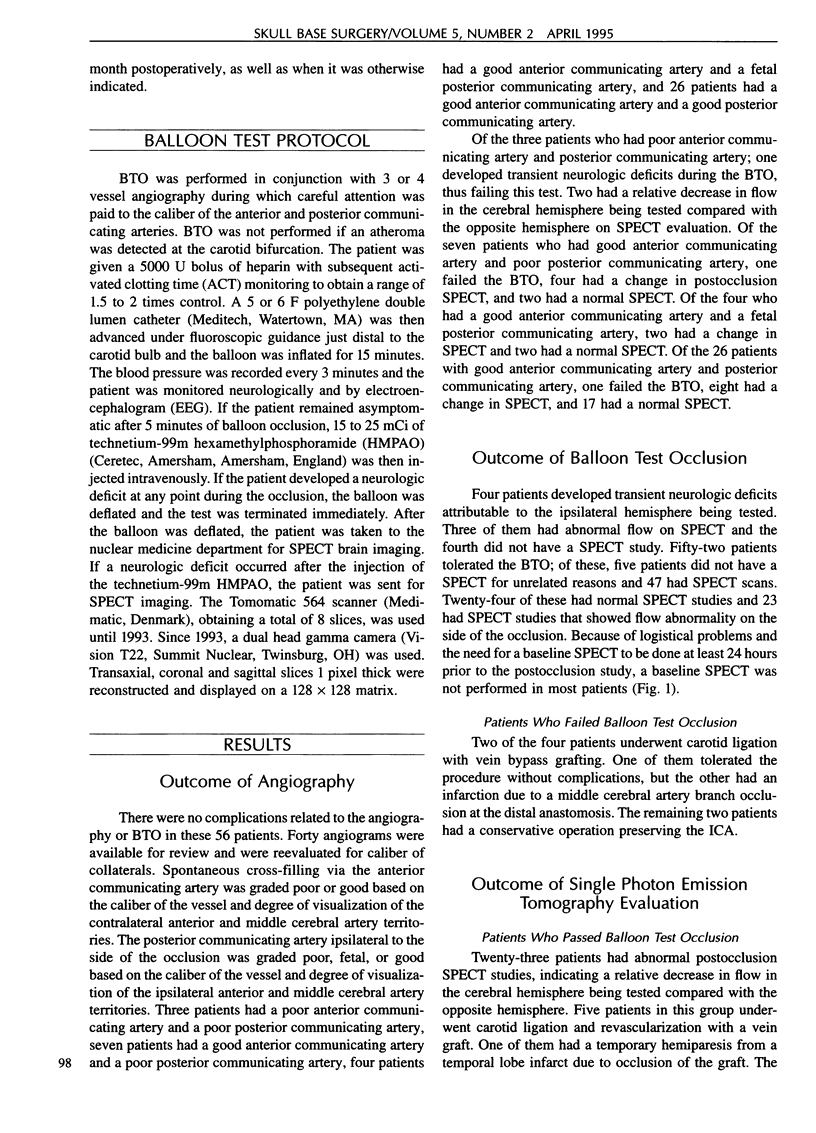
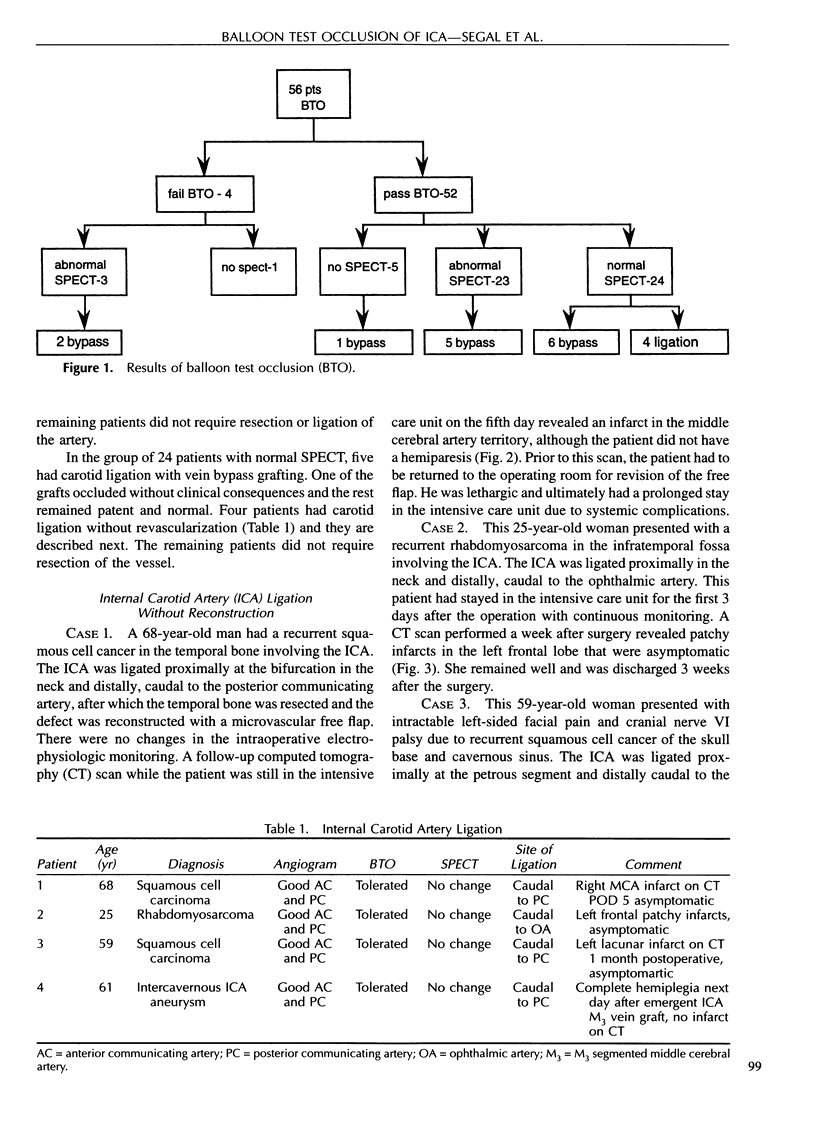
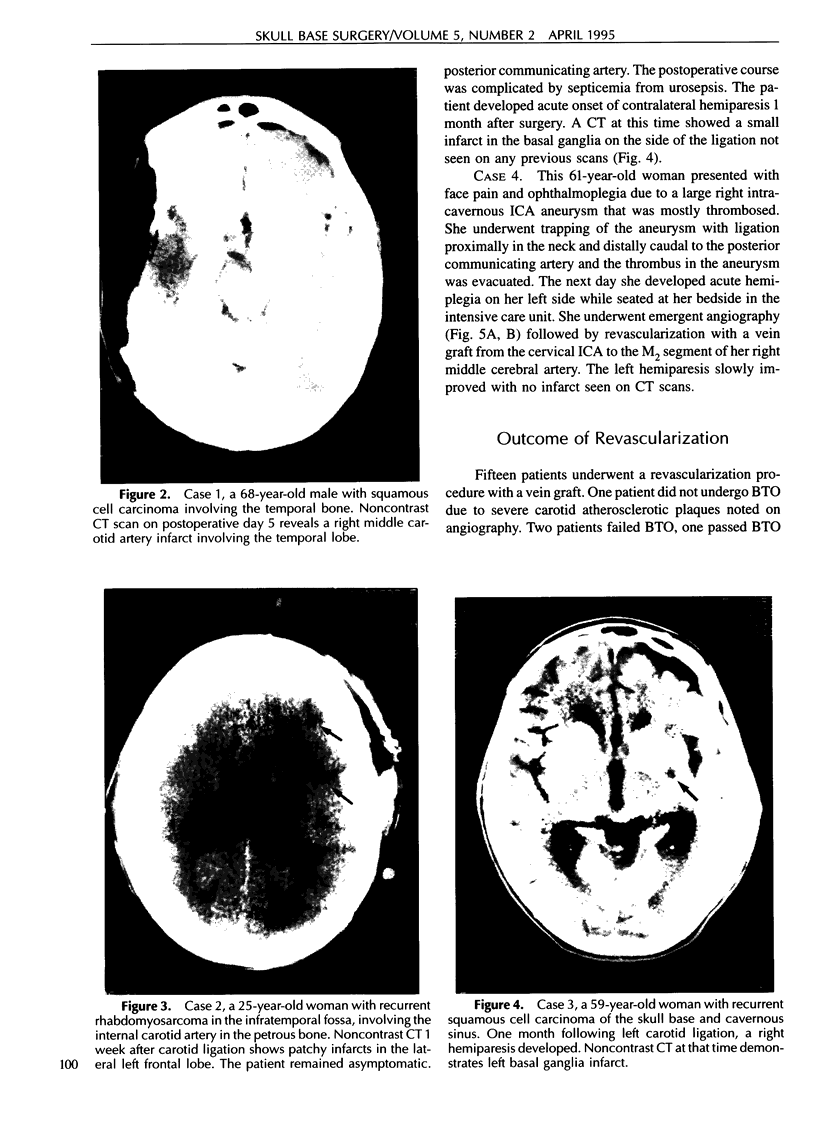
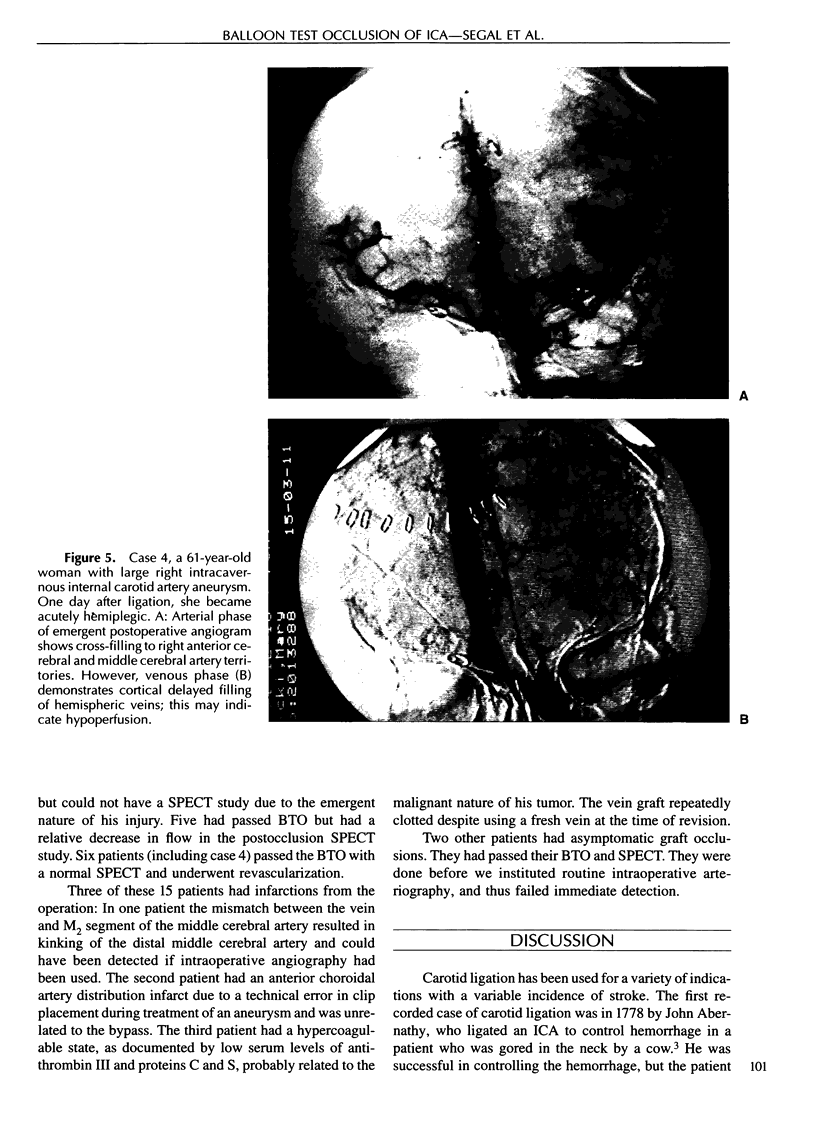
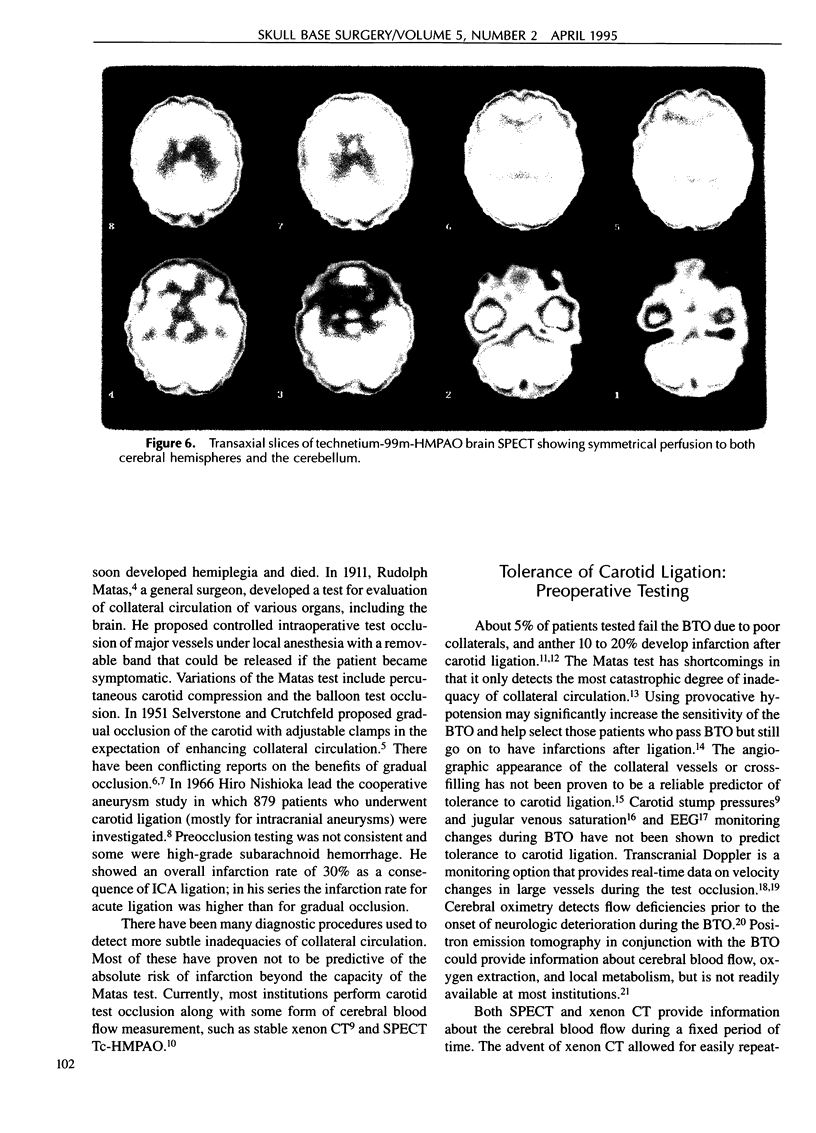
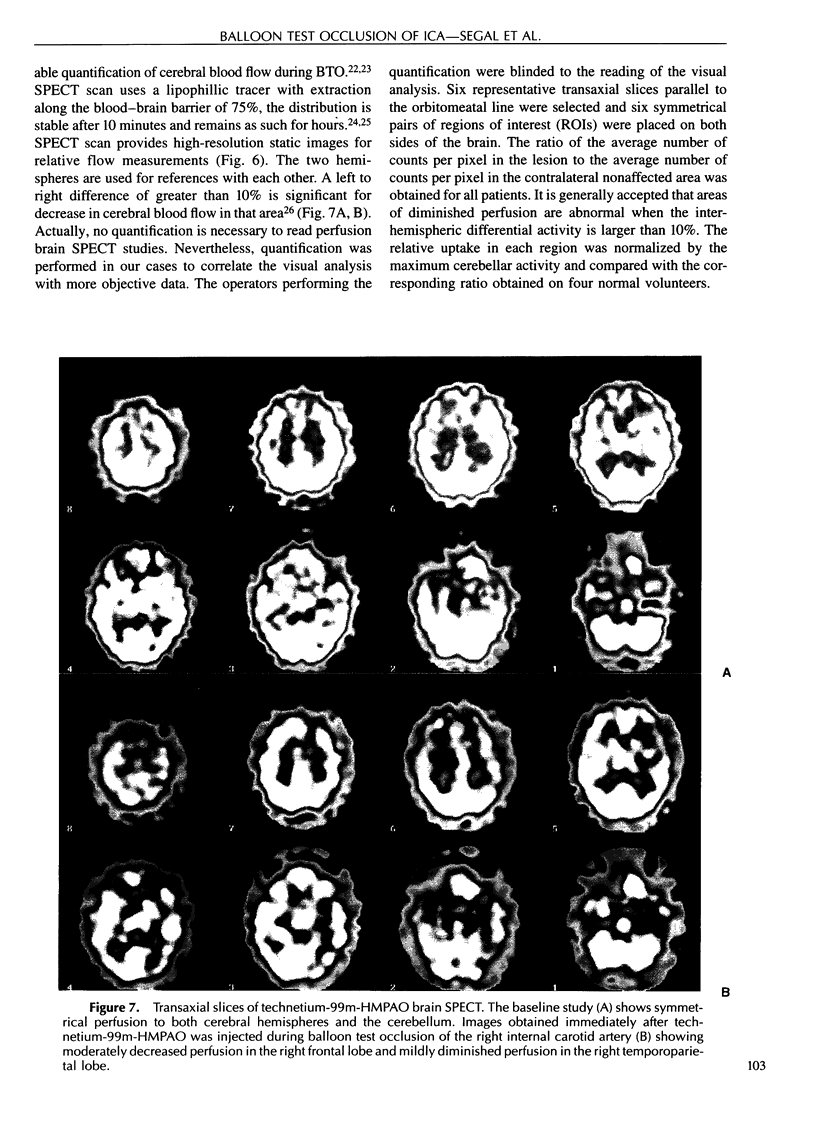
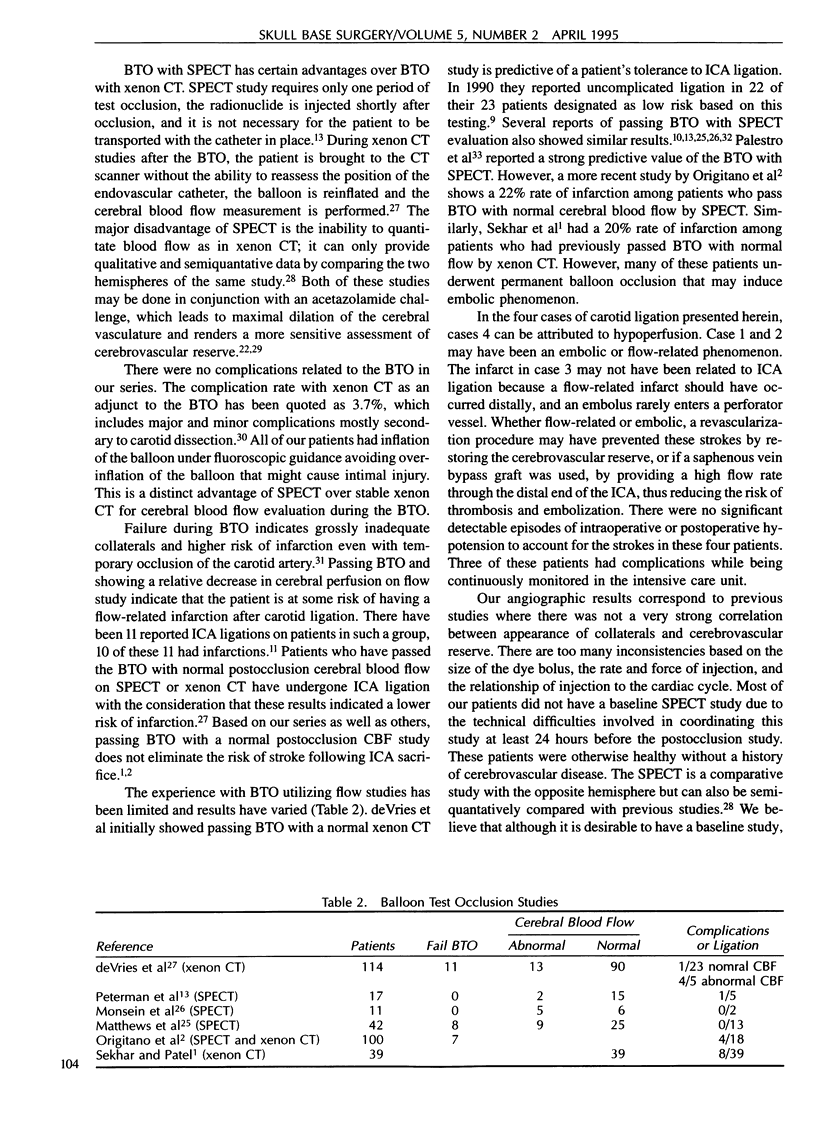
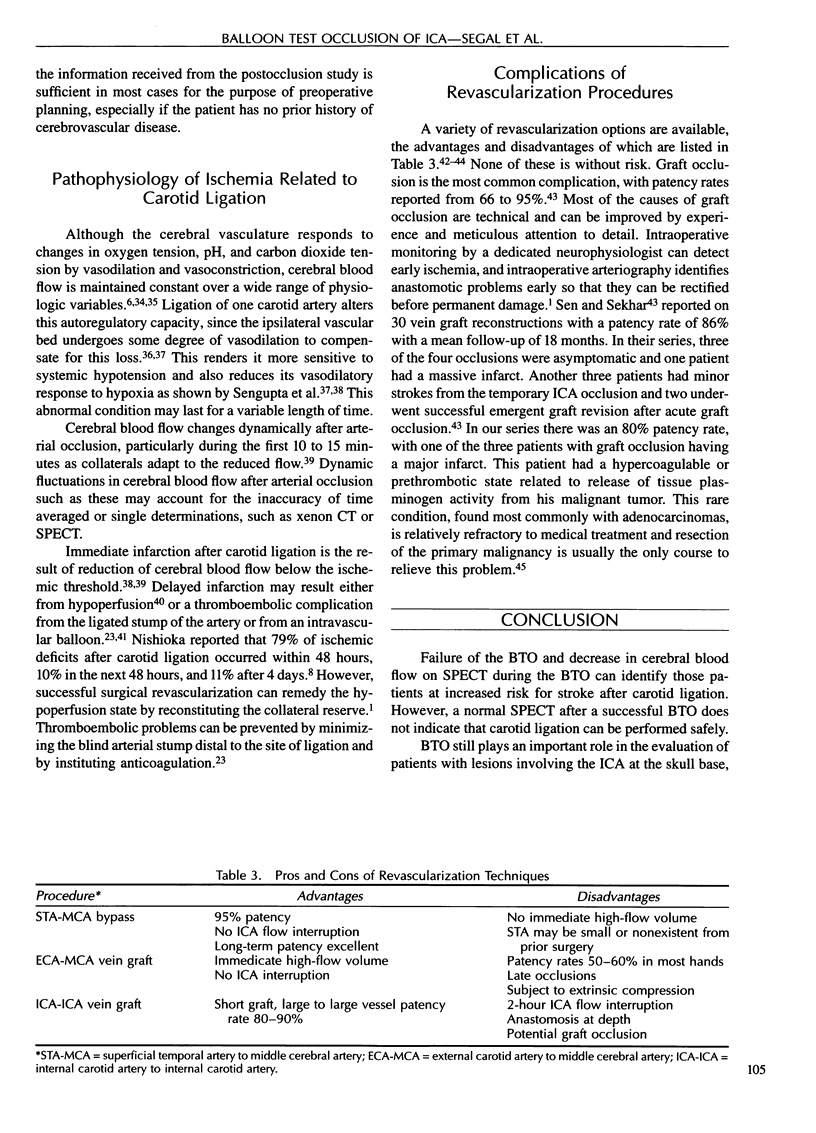
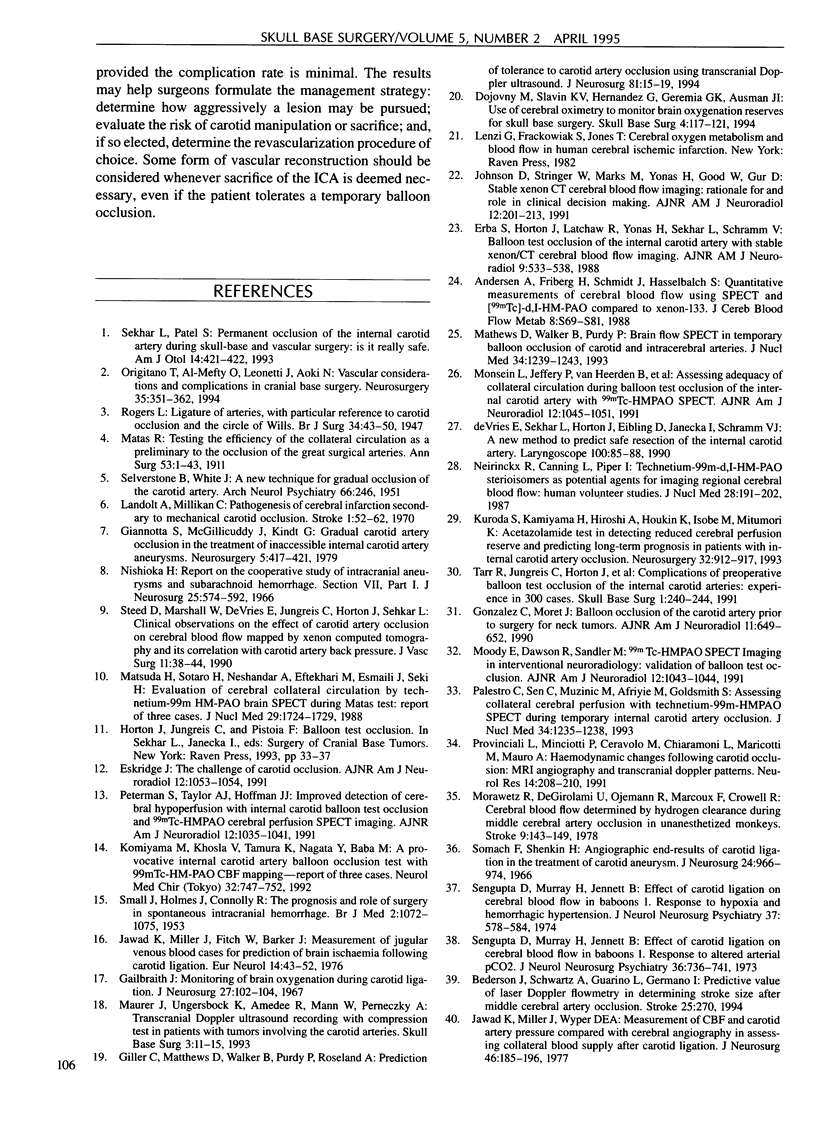
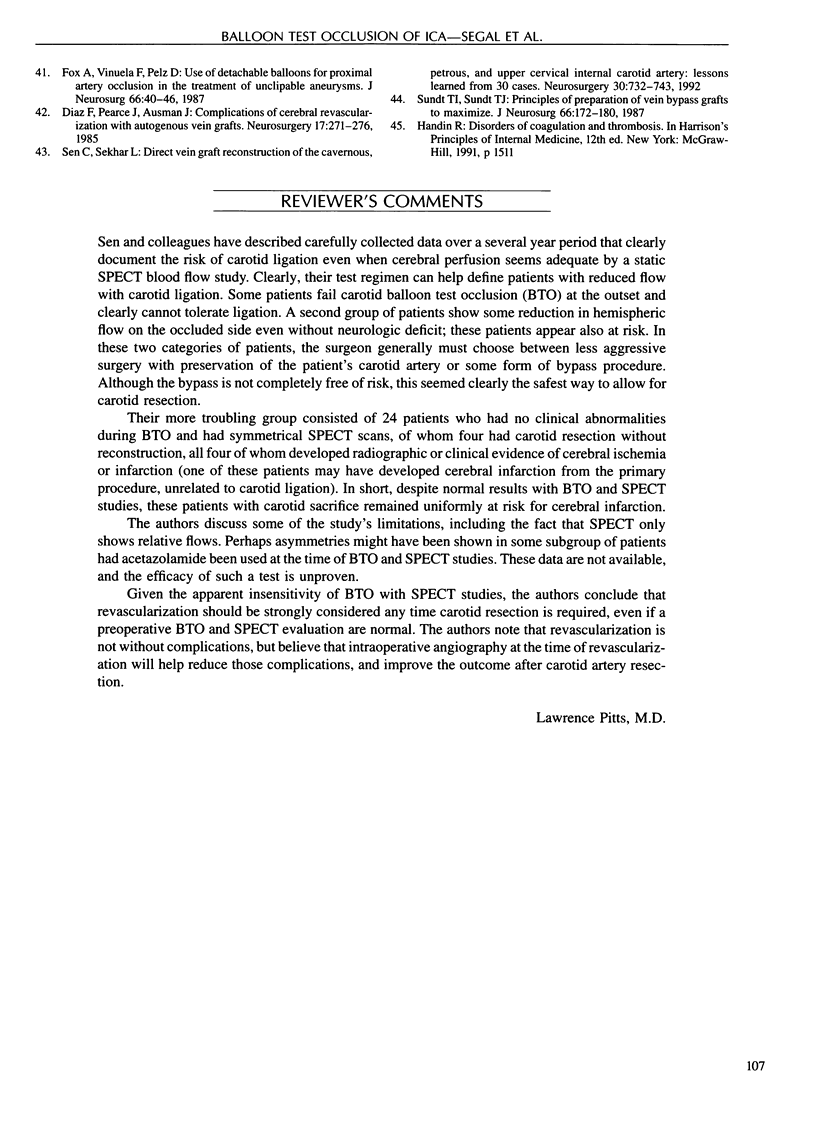
Images in this article
Selected References
These references are in PubMed. This may not be the complete list of references from this article.
- Andersen A. R., Friberg H. H., Schmidt J. F., Hasselbalch S. G. Quantitative measurements of cerebral blood flow using SPECT and [99mTc]-d,l-HM-PAO compared to xenon-133. J Cereb Blood Flow Metab. 1988 Dec;8(6):S69–S81. doi: 10.1038/jcbfm.1988.35. [DOI] [PubMed] [Google Scholar]
- Diaz F. G., Pearce J., Ausman J. I. Complications of cerebral revascularization with autogenous vein grafts. Neurosurgery. 1985 Aug;17(2):271–276. doi: 10.1227/00006123-198508000-00004. [DOI] [PubMed] [Google Scholar]
- Dujovny M., Slavin K. V., Hernandez G., Geremia G. K., Ausman J. I. Use of cerebral oximetry to monitor brain oxygenation reserves for skull base surgery. Skull Base Surg. 1994;4(3):117–121. doi: 10.1055/s-2008-1058961. [DOI] [PMC free article] [PubMed] [Google Scholar]
- Erba S. M., Horton J. A., Latchaw R. E., Yonas H., Sekhar L., Schramm V., Pentheny S. Balloon test occlusion of the internal carotid artery with stable xenon/CT cerebral blood flow imaging. AJNR Am J Neuroradiol. 1988 May-Jun;9(3):533–538. [PMC free article] [PubMed] [Google Scholar]
- Eskridge J. M. The challenge of carotid occlusion. AJNR Am J Neuroradiol. 1991 Nov-Dec;12(6):1053–1054. [PMC free article] [PubMed] [Google Scholar]
- Fox A. J., Viñuela F., Pelz D. M., Peerless S. J., Ferguson G. G., Drake C. G., Debrun G. Use of detachable balloons for proximal artery occlusion in the treatment of unclippable cerebral aneurysms. J Neurosurg. 1987 Jan;66(1):40–46. doi: 10.3171/jns.1987.66.1.0040. [DOI] [PubMed] [Google Scholar]
- Giannotta S. L., McGillicuddy J. E., Kindt G. W. Gradual carotid artery occlusion in the treatment of inaccessible internal carotid artery aneurysms. Neurosurgery. 1979 Oct;5(4):417–421. doi: 10.1227/00006123-197910000-00001. [DOI] [PubMed] [Google Scholar]
- Giller C. A., Mathews D., Walker B., Purdy P., Roseland A. M. Prediction of tolerance to carotid artery occlusion using transcranial Doppler ultrasound. J Neurosurg. 1994 Jul;81(1):15–19. doi: 10.3171/jns.1994.81.1.0015. [DOI] [PubMed] [Google Scholar]
- Gonzalez C. F., Moret J. Balloon occlusion of the carotid artery prior to surgery for neck tumors. AJNR Am J Neuroradiol. 1990 Jul-Aug;11(4):649–652. [PMC free article] [PubMed] [Google Scholar]
- Jawad K., Miller D., Wyper D. J., Rowan J. O. Measurement of CBF and carotid artery pressure compared with cerebral angiography in assessing collateral blood supply after carotid ligation. J Neurosurg. 1977 Feb;46(2):185–196. doi: 10.3171/jns.1977.46.2.0185. [DOI] [PubMed] [Google Scholar]
- Jawad K., Miller J. D., Fitch W., Barker J. Measurement of jugular venous blood gases for prediction of brain ischaemia following carotid ligation. A comparison with direct measurements of cerebral blood flow. Eur Neurol. 1976;14(1):43–52. doi: 10.1159/000114725. [DOI] [PubMed] [Google Scholar]
- Johnson D. W., Stringer W. A., Marks M. P., Yonas H., Good W. F., Gur D. Stable xenon CT cerebral blood flow imaging: rationale for and role in clinical decision making. AJNR Am J Neuroradiol. 1991 Mar-Apr;12(2):201–213. [PMC free article] [PubMed] [Google Scholar]
- Komiyama M., Khosla V. K., Tamura K., Nagata Y., Baba M. A provocative internal carotid artery balloon occlusion test with 99mTc-HM-PAO CBF mapping--report of three cases. Neurol Med Chir (Tokyo) 1992 Sep;32(10):747–752. doi: 10.2176/nmc.32.747. [DOI] [PubMed] [Google Scholar]
- Kuroda S., Kamiyama H., Abe H., Houkin K., Isobe M., Mitsumori K. Acetazolamide test in detecting reduced cerebral perfusion reserve and predicting long-term prognosis in patients with internal carotid artery occlusion. Neurosurgery. 1993 Jun;32(6):912–919. doi: 10.1227/00006123-199306000-00005. [DOI] [PubMed] [Google Scholar]
- Landolt A. M., Millikan C. H. Pathogenesis of cerebral infarction secondary to mechanical carotid artery occlusion. Stroke. 1970 Jan-Feb;1(1):52–62. doi: 10.1161/01.str.1.1.52. [DOI] [PubMed] [Google Scholar]
- Matas R. I. Testing the Efficiency of the Collateral Circulation as a Preliminary to the Occlusion of the Great Surgical Arteries. Ann Surg. 1911 Jan;53(1):1–43. doi: 10.1097/00000658-191101000-00001. [DOI] [PMC free article] [PubMed] [Google Scholar]
- Mathews D., Walker B. S., Purdy P. D., Batjer H., Allen B. C., Eckard D. A., Devous M. D., Sr, Bonte F. J. Brain blood flow SPECT in temporary balloon occlusion of carotid and intracerebral arteries. J Nucl Med. 1993 Aug;34(8):1239–1243. [PubMed] [Google Scholar]
- Matsuda H., Higashi S., Asli I. N., Eftekhari M., Esmaili J., Seki H., Tsuji S., Oba H., Imai K., Terada H. Evaluation of cerebral collateral circulation by technetium-99m HM-PAO brain SPECT during Matas test: report of three cases. J Nucl Med. 1988 Oct;29(10):1724–1729. [PubMed] [Google Scholar]
- Maurer J., Ungersbock K., Amedee R. G., Mann W. J., Perneczky A. Transcranial Doppler ultrasound recording with compression test in patients with tumors involving the carotid arteries. Skull Base Surg. 1993;3(1):11–15. doi: 10.1055/s-2008-1060559. [DOI] [PMC free article] [PubMed] [Google Scholar]
- Monsein L. H., Jeffery P. J., van Heerden B. B., Szabo Z., Schwartz J. R., Camargo E. E., Chazaly J. Assessing adequacy of collateral circulation during balloon test occlusion of the internal carotid artery with 99mTc-HMPAO SPECT. AJNR Am J Neuroradiol. 1991 Nov-Dec;12(6):1045–1051. [PMC free article] [PubMed] [Google Scholar]
- Moody E. B., Dawson R. C., 3rd, Sandler M. P. 99mTc-HMPAO SPECT imaging in interventional neuroradiology: validation of balloon test occlusion. AJNR Am J Neuroradiol. 1991 Nov-Dec;12(6):1043–1044. [PMC free article] [PubMed] [Google Scholar]
- Morawetz R. B., DeGirolami U., Ojemann R. G., Marcoux F. W., Crowell R. M. Cerebral blood flow determined by hydrogen clearance during middle cerebral artery occlusion in unanesthetized monkeys. Stroke. 1978 Mar-Apr;9(2):143–149. doi: 10.1161/01.str.9.2.143. [DOI] [PubMed] [Google Scholar]
- Neirinckx R. D., Canning L. R., Piper I. M., Nowotnik D. P., Pickett R. D., Holmes R. A., Volkert W. A., Forster A. M., Weisner P. S., Marriott J. A. Technetium-99m d,l-HM-PAO: a new radiopharmaceutical for SPECT imaging of regional cerebral blood perfusion. J Nucl Med. 1987 Feb;28(2):191–202. [PubMed] [Google Scholar]
- Nishioka H. Report on the cooperative study of intracranial aneurysms and subarachnoid hemorrhage. Section VII. I. Evaluation of the conservative management of ruptured intracranial aneurysms. J Neurosurg. 1966 Nov;25(5):574–592. doi: 10.3171/jns.1966.25.5.0574. [DOI] [PubMed] [Google Scholar]
- Origitano T. C., al-Mefty O., Leonetti J. P., DeMonte F., Reichman O. H. Vascular considerations and complications in cranial base surgery. Neurosurgery. 1994 Sep;35(3):351–363. doi: 10.1227/00006123-199409000-00001. [DOI] [PubMed] [Google Scholar]
- Palestro C. J., Sen C., Muzinic M., Afriyie M., Goldsmith S. J. Assessing collateral cerebral perfusion with technetium-99m-HMPAO SPECT during temporary internal carotid artery occlusion. J Nucl Med. 1993 Aug;34(8):1235–1238. [PubMed] [Google Scholar]
- Peterman S. B., Taylor A., Jr, Hoffman J. C., Jr Improved detection of cerebral hypoperfusion with internal carotid balloon test occlusion and 99mTc-HMPAO cerebral perfusion SPECT imaging. AJNR Am J Neuroradiol. 1991 Nov-Dec;12(6):1035–1041. [PMC free article] [PubMed] [Google Scholar]
- Provinciali L., Minciotti P., Ceravolo M. G., Chiaramoni L., Maricotti M., Mauro A., Salvolini U. Haemodynamic changes following carotid occlusion: MRI angiography and transcranial Doppler patterns. Neurol Res. 1992;14(2 Suppl):208–210. doi: 10.1080/01616412.1992.11740054. [DOI] [PubMed] [Google Scholar]
- SMALL J. M., HOLMES J. M., CONNOLLY R. C. The prognosis and role of surgery in spontaneous intracranial haemorrhage. Br Med J. 1953 Nov 14;2(4845):1072–1075. doi: 10.1136/bmj.2.4845.1072. [DOI] [PMC free article] [PubMed] [Google Scholar]
- Sekhar L. N., Patel S. J. Permanent occlusion of the internal carotid artery during skull-base and vascular surgery: is it really safe? Am J Otol. 1993 Sep;14(5):421–422. doi: 10.1097/00129492-199309000-00001. [DOI] [PubMed] [Google Scholar]
- Sen C., Sekhar L. N. Direct vein graft reconstruction of the cavernous, petrous, and upper cervical internal carotid artery: lessons learned from 30 cases. Neurosurgery. 1992 May;30(5):732–743. [PubMed] [Google Scholar]
- Sengupta D., Harper M., Jennett B. Effect of carotid ligation on cerebral blood flow in baboons. 2. Response to hypoxia and haemorrhagic hypertension. J Neurol Neurosurg Psychiatry. 1974 May;37(5):578–584. doi: 10.1136/jnnp.37.5.578. [DOI] [PMC free article] [PubMed] [Google Scholar]
- Sengupta D., Harper M., Jennett B. Effect of carotid ligation on cerebral blood flow in baboons. I. Response to altered arterial PCO2. J Neurol Neurosurg Psychiatry. 1973 Oct;36(5):736–741. doi: 10.1136/jnnp.36.5.736. [DOI] [PMC free article] [PubMed] [Google Scholar]
- Somach F. M., Shenkin H. A. Angiographic end-results of carotid ligation in the treatment of carotid aneurysm. J Neurosurg. 1966 Jun;24(6):966–974. doi: 10.3171/jns.1966.24.6.0966. [DOI] [PubMed] [Google Scholar]
- Steed D. L., Webster M. W., DeVries E. J., Jungreis C. A., Horton J. A., Sehkar L., Yonas H. Clinical observations on the effect of carotid artery occlusion on cerebral blood flow mapped by xenon computed tomography and its correlation with carotid artery back pressure. J Vasc Surg. 1990 Jan;11(1):38–44. [PubMed] [Google Scholar]
- Sundt T. M., 3rd, Sundt T. M., Jr Principles of preparation of vein bypass grafts to maximize patency. J Neurosurg. 1987 Feb;66(2):172–180. doi: 10.3171/jns.1987.66.2.0172. [DOI] [PubMed] [Google Scholar]
- Tarr R. W., Jungreis C. A., Horton J. A., Pentheny S., Sekhar L. N., Sen C., Janecka I. P., Yonas H. Complications of preoperative balloon test occlusion of the internal carotid arteries: experience in 300 cases. Skull Base Surg. 1991;1(4):240–244. doi: 10.1055/s-2008-1057104. [DOI] [PMC free article] [PubMed] [Google Scholar]
- de Vries E. J., Sekhar L. N., Horton J. A., Eibling D. E., Janecka I. P., Schramm V. L., Jr, Yonas H. A new method to predict safe resection of the internal carotid artery. Laryngoscope. 1990 Jan;100(1):85–88. doi: 10.1288/00005537-199001000-00017. [DOI] [PubMed] [Google Scholar]



